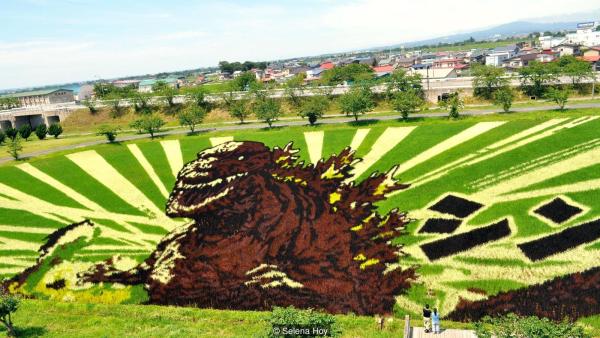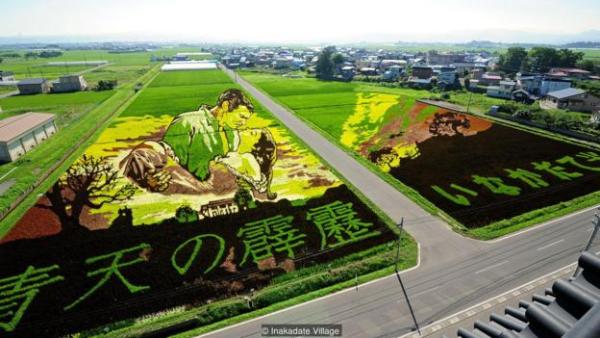Every year, a Japanese village in northern Aomori Prefecture creates field-sized, living, 3D paintings made of coloured rice shoots.
每年,在日本青森县北部的一个村子,人们都会用不同颜色的秧苗种出栩栩如生的3D稻田画,图像有整亩田大小。
From ground level, it didn’t look like much. In fact, the scene looked like a lot of rural Japan: rice paddies with tender shoots in shades of green, rippling in the wind and stretching off into the horizon. Bucolic, surely, but nothing unusual.
人站在地面上是看不出什么图像的,倒是和一般的日本农村风光差不了多少:稻田里满是绿色的娇嫩的禾苗,被微风拂过后荡着波纹一直延伸向远方,好一派田园风光,并没有什么特别之处。
But as I ascended the viewing platform and took the longer view, something started to emerge. What had been patches of pale green and reddish brown started to take shape into a detailed tableau of Godzilla mid-attack, in a scene so sprawling it wouldn’t fit into my camera’s normal frame. It was so impressive it almost looked as though the monster would rise up out of the field and start crushing the little houses in the distance under his feet, perhaps crunching a few humans in his well-defined teeth.
但是当我爬上观景台扩大视野后,一些新的东西呈现在我眼前。原本还只是浅绿色和红褐色的秧苗,现在却构成了一幅攻击中的哥斯拉图像,整个画面如此巨大,塞不进我照相机的取景框。这场景实在是太震撼了,这头怪兽仿佛就要从稻田里一跃而起,踩碎在它脚边较远处的小房子,也许再用尖牙咬碎几个人。
This astonishing art form is something that hundreds of thousands of people are flocking to the village of Inakadate, in Japan’s northern Aomori Prefecture, to see.
这种令人叹为观止的艺术形式吸引着成千上万的游客,他们成群结队的赶往日本青森县北部这个叫做田舍馆村的地方一睹为快。
Tanbo art,which translates to ‘Rice Paddy Art’, consists of thousands of strategically planted rice shoots grown in concert to produce field-sized, living, 3D paintings. The imaginative undertaking started back in 1992, when the then-mayor instructed his staff to think of an event that would draw crowds to the village.
Tanbo艺术,也就是稻田艺术,由上千根禾苗组成,它们按照一定的方式有序地种在田里,构成整亩田大小的生动的3D画面。这个创意还得追溯到1992年,当时村长要求下属们策划一个活动以增加村庄客流量。
Takatoshi Asari of the village’s tourism and planning division explained that “one employee had seen an elementary school rice paddy that was planted with yellow, purple and green rice plants in a striped pattern, and thought, ‘What if we planted a field with three colours of rice plants to make a drawing with text?’ There was no concept of art at the time.”
该村旅游企划部的Takatoshi Asari是这样描述的:“当时有个工作人员曾经在一所小学的稻田里看到过黄色、紫色和绿色的禾苗种成条纹形状,于是他就想‘如果我们也在田里种上三种颜色的稻谷以此来组成图画,再配上文字,那会怎么样?’在那个时候我们还没有形成稻田艺术的概念。”
When I asked my guide Hiroki Fukushi, “Why rice?”, he replied: “This is a village with nothing but rice fields. So we thought, let’s do with what we have.”
我问导游Hiroki Fukushi“为什么当时会选择稻谷?”他回答说“这个村子别的没有只有大片的稻田,所以我们想那就用这些现成的稻谷吧。”
In this remote village of just more than 8,000 people, rice agriculture is a cornerstone of life. Rice has been cultivated in the area for around 2,000 years; Inakadate’s official flower isinenohana, or rice flower; and the village song also features the rice flower.
在这个人口只有八千多点的偏远小镇上,水稻种植是他们赖以生存的基础。在这里,水稻的种植史已有差不多两千年,田舍馆村的村花就是稻花,并且村歌也以稻花为主题。
The first year, about 100 villagers helped to plant the rice there. The result was a simple geometric representation of nearby MIwakti, with the words ‘Rice Culture Village Inakadate’ in Japanese. Very few spectators turned up. Realising that they needed to create something more impressive, “every year, we increased the colours of rice plants that were used, and the technology for creating the art improved,” Asari said.
在第一年总共有大约100位村民帮忙种植水稻,他们用简单的几何图形组成了附近Iwakti山的形状,再配上几个日文文字“稻田文化 田舍馆村”。当时只有很少的人数前往参观。人们意识到他们必须创造出更具影响力的图像。"每年我们都会增加禾苗的颜色种类并提升制作技术。"Asari说道。
Atsushi Yamamoto, the art teacher at the village school, is in charge of drawing the plans.
Atsushi Yamamoto是村里学校的美术老师,他负责稻田里图画的设计。
“My aunt worked at the village hall. In the year of Heisei 15 [2003], there was a plan to make a rice-paddy artwork of Mona Lisa, but it was complicated,” he explained. Unsure of how to create the more ambitious picture compared to the simple Mt Iwaki that they had been doing for 10 years, the village council came to seek his expertise.
“我姨妈在村公所工作。平成15年(2003年),村里计划在稻田里种出蒙娜丽萨的画像,但是这项工程太复杂了”。他说道。村子已经在稻田里种了十年的Iwakti山简单几何图案,他们不知道该如何创造出更加精细的图画,于是村委会前来寻求Atsushi Yamamoto的帮助。
Yamamoto drew the Mona Lisa plans, with mixed success. The perspective was off, and some said that the famous mystery woman looked fat.
Yamamoto设计出蒙娜丽莎的稻田图像,人们对此褒贬不一。画面的透视效果并不好,有的人说这个有名的神秘女人看上去胖了点。
“At the beginning when I started rice paddy art, there were some failures, but after some trial and error, I gained experience, and now, the rice paddy art comes out the way it’s envisioned,” he said.
“在我刚开始创作稻田艺术的时候,有过几次失败,但是在后来经历过更多的尝试和失败后,我吸取了一些经验。现在稻田里呈现的实际画面跟设计稿一模一样。”
The project has certainly come a long way since Mt Iwaki and Mona Lisa. The annual Tanbo art now has a planning process, which starts in autumn after rice harvest and is wrapped up in April, a month or so before planting commences, explained the village mayor, Koyu Suzuki.
这个艺术项目在Iwaki山和蒙娜丽莎之后取得了进一步的进展。现在每年的稻田艺术有了一个设计流程,从秋天收割完稻子后开始,一直到四月打包完成,此时距离开始种植还有一个月左右的时间。村长Koyu Suzuki说道。
“The theme is decided at the Village Revitalization Promotion Council. We try to choose a design that will be enjoyable to many different people,” Suzuki said.
“画面主题由村振兴促进委员会决定,我们尽量选择大部分人都喜欢的图像。”Suzuki说。
Next, Yamamoto makes the drawing, and a survey company in the village produces a computer-aided design (CAD) blueprint, which helps ensure that the perspective of the artwork will look right when viewed from the observation points.
接下来Yamamoto开始设计图像,村里的一个调研公司会做出CAD图纸,这样能够确保从观景点看去,稻田里的图像透视正确。
The planting occurs in late spring, and the paddies, in two locations in the village, grow from May to October. “There are 12 varieties of rice plants used, and seven colours. Right after planting the seeds, you can’t tell the difference between the colours, but once the rice plants start growing, you can tell the difference quite distinctly,” said Inakadate tourism section chief Masaru Fukushi, who is also in charge of paddy maintenance.
春末时分禾苗会在村里的两处稻田里种下,然后从5月生长到10月。“一共使用了12种水稻,共7种颜色。刚种下去的时候是看不出颜色有何不同的,但是随着水稻的长大,你能很清楚的辨认出颜色来。”田舍馆村旅游事业部主管Masaru Fukushi说道,他同时也 负责维护稻田里的图像。
The images begin to emerge from the mud sometime in June, but the living paintings reach peak splendour in July and August, when the viewing areas are crowded with spectators. From the humble numbers of the 1990s, a total of 340,000 visitors came to the two viewing sites in 2016. The town has even built a train station, Tanbo Art Station, and a special viewing tower to accommodate all the people.
图像会在六月里的某一天拔地而起,但是要到七八月才能达到顶峰,那时周边会聚集很多游客。前往两处观光点的游客数量从90年代少得可怜的几人增长成2016年的34万。镇上甚至建造了一个火车站——稻田艺术火车站,还特设了一个可以容纳所有人的观景塔。
The themes over the years have included scenes from Star Wars and Gone with the Wind, but increasingly, the villagers are tending toward Japanese motifs. In 2016, the year I visited, the main pictures were of Godzilla and actors from the TV drama Sanada Maru, a historical samurai show that was popular last year.
多年来图像的主题包括取自《星球大战》和《乱世佳人》的场景,但是村民们逐渐倾向于具有日本元素的图像。在我前往参观的2016年,当年的主要图像就是哥斯拉,以及2015年人气很高的历史武士剧《真田丸》中的演员。
Suzuki was coy when I asked for a hint of this year’s artwork, but did say that “it will be a Japanese style design. Like something out of the Kojiki [Japan’s oldest extant text, dating from the 8th Century].”
当我问及能否透露今年的主题时,Suzuki 表现得很腼腆,但他说“今年的主题会走日本风,和《古事记》有关(《古事记》是日本现存的最古老的文学作品,创作于8世纪)。”
The Kojiki and rice: what could be more quintessential Japan?
用稻谷展示的《古事记》,还会有什么比这个更加日本呢?
*原文来自BBC Travel频道,仅做翻译练习之用。*
8









